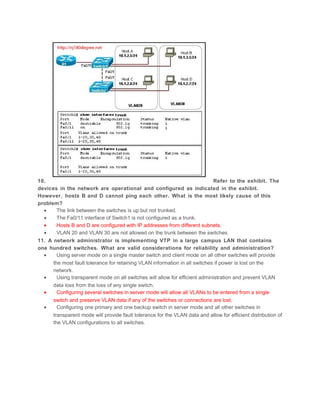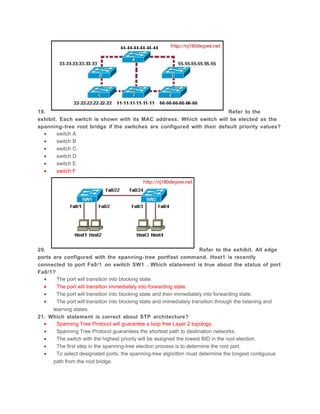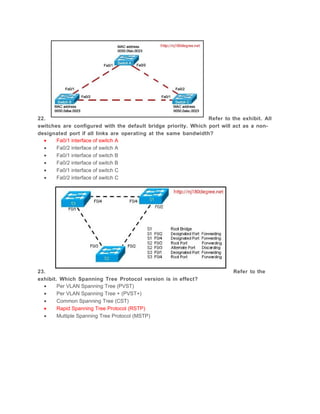Final exam ccna exploration 3 lan switching and wireless
- 1. CCNA Exploration 3 LAN Switching and Wireless– Final exam 1. Refer to the exhibit. A network administrator needs to add IP phones to the network. To which devices should the IP phones connect? ? AS1 and AS2 ? DS1 and DS2 ? DS1, DS2, and CS1 ? AS1, AS2, DS1, and DS2 2. Which CLI mode allows users to access all device commands, such as those used for configuration, management, and troubleshooting? ? user EXEC mode ? privileged EXEC mode ? global configuration mode ? interface configuration mode 3. Refer to the exhibit. All hosts are in listen mode. Host 1 and Host 4 both transmit data at the same time. How do the hosts respond on the network? (Choose two.) ? After the end of the jam signal, a backoff algorithm is invoked. ? Hosts 1 and 4 are operating full duplex so no collision will exist. ? The hub will block the port connected to Host 4 to prevent a collision.
- 2. ? Hosts 1 and 4 are assigned shorter backoff values to provide them priority to access the media. ? If a host has data to transmit after the backoff period of that host, the host checks to determine if the line is idle before transmitting. 4. Refer to the exhibit. An administrator documented the output of a CAM table from an Ethernet switch as shown. What action will the switch take when it receives the frame shown at the bottom of the exhibit? ? discard the frame ? forward the frame out port 2 ? forward the frame out port 3 ? forward the frame out all ports ? forward the frame out all ports except port 3 ? add station 00-00-3D-1F-11-05 to port 2 in the forwarding table 5. What two methods can be used to remove MAC address table entries from a switch? (Choose two.) ? Power cycle the switch to clear all dynamically learned addresses. ? The clear switching-tables command will remove statically configured entries. ? The clear mac-address-table command will remove statically and dynamically configured table entries. ? The erase flash command will clear all statically configured table entries. ? Statically configured MAC addresses will automatically be removed from the address table 300 minutes after the last activity on a switch port. 6. Which three statements are correct concerning the default configuration of a new switch? (Choose three.) ? It is configured in VTP server mode. ? STP is automatically enabled. ? The first VTY line is automatically configured to allow remote connections. ? VLAN1 is configured with a management IP address. ? All switch ports are assigned to VLAN1. ? The enable password is configured as cisco 7. What will be the effect of the command S1# copy system:running- config tftp://172.16.2.155/tokyo- config? ? The IOS will be copied to the TFTP server. ? The configuration file named tokyo-config will overwrite the startup configuration file on S1. ? The running configuration file on S1 will be saved via TFTP to a file named tokyo-config.
- 3. ? The contents of NVRAM on S1 will become the startup configuration file on the tokyo switch. 8. Refer to the exhibit. What does the term DYNAMIC indicate in the output that is shown? ? This entry can only be removed from the MAC address table by a network administrator. ? When forwarding a frame to the device with address 0060.5c5b.cd23, the switch does not have to perform a lookup to determine the final destination port. ? Only the device with MAC address 0060.5c5b.cd23 will be allowed to connect to port Fa0/18. ? The switch learned this MAC address from the source address in a frame received on Fa0/18. 9. Company policy requires disabling the command history buffer on network devices. An administrator enters terminal no history size at the command prompt on a Cisco Catalyst switch and receives no error messages back, but the command history buffer is still available. What is the problem? ? The command contained a syntax error. ? The Cisco IOS version does not support disabling the command history buffer. ? The command history can only be disabled on a router, not a switch. ? The size parameter reset the default buffer size but did not disable access to the buffer.
- 4. 10. Refer to the exhibit. The devices in the network are operational and configured as indicated in the exhibit. However, hosts B and D cannot ping each other. What is the most likely cause of this problem? ? The link between the switches is up but not trunked. ? The Fa0/11 interface of Switch1 is not configured as a trunk. ? Hosts B and D are configured with IP addresses from different subnets. ? VLAN 20 and VLAN 30 are not allowed on the trunk between the switches. 11. A network administrator is implementing VTP in a large campus LAN that contains one hundred switches. What are valid considerations for reliability and administration? ? Using server mode on a single master switch and client mode on all other switches will provide the most fault tolerance for retaining VLAN information in all switches if power is lost on the network. ? Using transparent mode on all switches will allow for efficient administration and prevent VLAN data loss from the loss of any single switch. ? Configuring several switches in server mode will allow all VLANs to be entered from a single switch and preserve VLAN data if any of the switches or connections are lost. ? Configuring one primary and one backup switch in server mode and all other switches in transparent mode will provide fault tolerance for the VLAN data and allow for efficient distribution of the VLAN configurations to all switches.
- 5. 12. Refer to the exhibit. Switch SW- A is to be used as a temporary replacement for another switch in the VTP Student domain. What two pieces of information are indicated from the exhibited output? (Choose two.) ? The other switches in the domain can be running either VTP version 1 or 2. ? There is a risk that the switch may cause incorrect VLAN information to be sent through the domain. ? VTP will block frame forwarding on at least one redundant trunk port that is configured on this switch. ? VLAN configuration changes made on this switch will be sent to other devices in the VTP domain. ? This switch will update its VLAN configuration when VLAN changes are made on a VTP server in the same domain. 13. What is the purpose of issuing the command switchport mode access on a switch interface? ? disable port security ? make the port operational ? override the default port behavior ? force the port to be a part of a single vlan 14. Refer to the exhibit. What happens when a frame from a source MAC address different from 00a8.d2e4.ba27 reaches switch port 0/5? ? The frame is dropped. ? The port is shut down. ? An error message is displayed. ? FastEthernet port 0/5 will show an err-disabled message.
- 6. 15. Refer to the exhibit. What will be the result of the commands that are shown in the exhibit? ? Only clients on VLAN 2 will be able to use DHCP for addressing. ? DHCP server responses will only be permitted on interface Fa0/2. ? Only 100 clients are permitted to request DHCP addresses on VLAN 2. ? Client requests for DHCP addresses will be filtered out if the requests are not received on interface Fa0/2. 16. Why is it important that the network administrator consider the spanning- tree network diameter when choosing the root bridge? ? The network diameter limitation is 9. ? BPDUs may be discarded because of expiring timers. ? The cabling distance between the switches is 100 meters. ? The network diameter must be set to the number of meters of the cable between the root bridge and its farthest connected switch. 17. What is the purpose of the Spanning Tree algorithm? ? It propagates VLAN configurations to other switches. ? It restricts broadcast packets to a single VLAN. ? It segments a network into multiple broadcast domains. ? It prevents loops in a switched network with redundant paths. 18. Refer to the exhibit. What is the result of issuing these commands? ? The enable password will be set. ? The password will be set for the first Telnet connection. ? The password will be set for the console connection. ? The password will be set for the auxiliary connection.
- 7. 19. Refer to the exhibit. Each switch is shown with its MAC address. Which switch will be elected as the spanning- tree root bridge if the switches are configured with their default priority values? ? switch A ? switch B ? switch C ? switch D ? switch E ? switch F 20. Refer to the exhibit. All edge ports are configured with the spanning- tree portfast command. Host1 is recently connected to port Fa0/1 on switch SW1 . Which statement is true about the status of port Fa0/1? ? The port will transition into blocking state. ? The port will transition immediately into forwarding state. ? The port will transition into blocking state and then immediately into forwarding state. ? The port will transition into blocking state and immediately transition through the listening and learning states. 21. Which statement is correct about STP architecture? ? Spanning Tree Protocol will guarantee a loop free Layer 2 topology. ? Spanning Tree Protocol guarantees the shortest path to destination networks. ? The switch with the highest priority will be assigned the lowest BID in the root election. ? The first step in the spanning-tree election process is to determine the root port. ? To select designated ports, the spanning-tree algorithm must determine the longest contiguous path from the root bridge.
- 8. 22. Refer to the exhibit. All switches are configured with the default bridge priority. Which port will act as a non- designated port if all links are operating at the same bandwidth? ? Fa0/1 interface of switch A ? Fa0/2 interface of switch A ? Fa0/1 interface of switch B ? Fa0/2 interface of switch B ? Fa0/1 interface of switch C ? Fa0/2 interface of switch C 23. Refer to the exhibit. Which Spanning Tree Protocol version is in effect? ? Per VLAN Spanning Tree (PVST) ? Per VLAN Spanning Tree + (PVST+) ? Common Spanning Tree (CST) ? Rapid Spanning Tree Protocol (RSTP) ? Multiple Spanning Tree Protocol (MSTP)
- 9. 24. Refer to the exhibit. Each switch is configured to participate in STP for VLANs 1, 10, 20, and 30. Which switch will become the root for VLAN 20? ? A ? B ? C ? D 25. Refer to the exhibit. R1 is configured for traditional inter- VLAN routing. R1 can ping computer 3 but cannot ping computer 1. What is a possible cause for this failure?
- 10. ? S1 port Fa0/11 is in the wrong VLAN. ? R1 does not have an active routing protocol. ? The IP address of computer 1 is in the wrong logical network. ? Router interface Fa0/0 has the wrong trunk encapsulation type configured.










